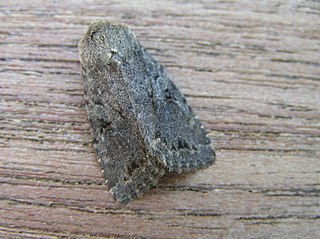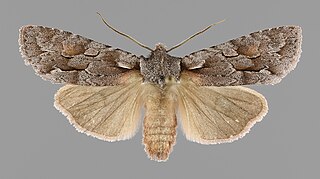Syngelechia is a genus of moths in the family Gelechiidae erected by Anthonie Johannes Theodorus Janse in 1958. Its only species, Syngelechia psimythota, was first described by Edward Meyrick in 1913. It is found in South Africa.

Fissipunctia ypsillon, the dingy shears, is a species of moth of the family Noctuidae. It is found in the Palearctic realm.

Agonopterix arenella is a species of moth of the family Depressariidae. It is found in all of Europe, except the Iberian Peninsula.

Agrotis trux, the crescent dart, is a moth of the family Noctuidae. The species was first described by Jacob Hübner in 1824. It has a circum-Mediterranean distribution and is found along the coasts of France, Ireland, England, southern Europe, Algeria, Syria, Iraq, Iran, southern Russia and the Arabian Peninsula. In Africa, it is found as far south as South Africa.

Lithophane lamda, the nonconformist, is a moth of the family Noctuidae. It is found throughout Europe, except in southern Europe. It is also absent from Iceland and Ireland.

Phyllocnistis unipunctella is a moth of the family Gracillariidae. It is known from all of Europe.

Depressaria badiella is a moth of the family Depressariidae. It is found in most of Europe, Libya, the Caucasus and Mongolia.

Orthotelia is a genus of moths in the subfamily Orthoteliinae.Orthotelia sparganella, a moth of the family Glyphipterigidae, is its only species.
Dichomeris ventosa is a species of moth in the family Gelechiidae. It was described by Edward Meyrick in 1913. It is found in Mpumalanga, South Africa.
Hypatima isoptila is a moth in the family Gelechiidae. It was described by Edward Meyrick in 1913. It is found in Sri Lanka.
Hypatima isotricha is a species of moth in the family Gelechiidae. It was described by Edward Meyrick in 1921. It is found on Java in Indonesia.
Anarsia tortuosa is a moth in the family Gelechiidae. It was described by Edward Meyrick in 1913. It is found in Japan (Ryukyus) and Sri Lanka.
Anacampsis poliombra is a moth of the family Gelechiidae. It was described by Edward Meyrick in 1922. It is found in Brazil (Amazonas).
Mothonica fluminata is a moth of the family Depressariidae. It is found in Colombia and Suriname.
Cerconota rosacea is a moth of the family Depressariidae. It is found in the Amazon region and French Guiana.
Lecithocera xanthophaea is a moth in the family Lecithoceridae. It was described by Edward Meyrick in 1926. It is found on Borneo.
Hypercallia alexandra is a moth in the family Depressariidae. It was described by Edward Meyrick in 1909. It is found in Peru.
Antaeotricha protosaris is a moth in the family Depressariidae. It was described by Edward Meyrick in 1915. It is found in the Guianas and Brazil.
Chlamydastis monastra is a moth in the family Depressariidae. It was described by Edward Meyrick in 1909. It is found in Peru.
Borkhausenia crimnodes is a species of moth from the family Oecophoridae. The scientific name of this species was published for the first time in 1912 by Edward Meyrick. It is found in the Southern Hemisphere, where it has been recorded from Argentina, South Africa and Portugal.






